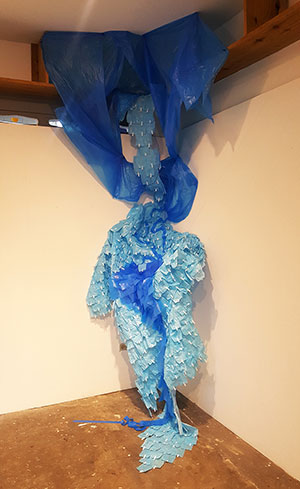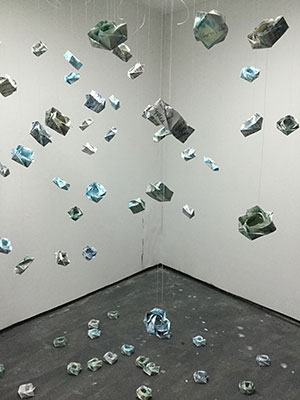Time, trauma and the female body
LAST Tuesday, Trinidadian artist Shanice Smith and I both presented works made during the month-long MOU residency to a modest crowd of artists and art enthusiasts at Alice Yard in Woodbrook, Port of Spain.

We had spent the previous day working ourselves to exhaustion readying the space and installing our individual pieces. It was a gruelling process of trying to figure out what “felt right” as we raced against the clock (this meant a lot of doing, undoing, redoing and subsequent frustration). Eventually, after experiencing what felt like a complete burn-out, we wrapped up at midnight. Unfortunately, my install was nowhere near completion and that meant another early start the next day. This seemed to be the general trend for the entire week leading up to the big day: early mornings, late nights and what seemed to be very little visible progress. By this time we were both on autopilot, sailing through the days in a zombie-like mode. Nevertheless, we managed to pull everything together just in time for the opening of the event.
One of the challenges I was forced to confront during the production phase was working away from the installation site until the very last minute. In my previous residency experiences, I would’ve had the opportunity to work on site from the beginning, making adjustments and tailoring the installations to the space over an extended period of time. In this case, however, I was working offsite, blindly trying to conceptualise what the work could be as I had no idea what my exhibition space looked like. This also meant the work would’ve had to be made in a way that facilitated easy transportation via maxi (bus). Since I had never worked this way before, I knew almost immediately that it would be an intense installation process. And it sure was.

Nevertheless, although the process presented challenges I hadn’t considered initially, it also brought into sharp focus some of the things that have come to be really important to me — one such thing being space. I came to the realisation that finding the right way of seamlessly working around quirky spaces carries just as much weight as the actual art object; for me, the two cannot be separated.
I’m usually very open about my process and unafraid to admit that I do have anxiety about the work I make. This time around was no different. I was incredibly nervous that my installations wouldn’t be as resolved as I would’ve liked, given that I had only two days to make them work in the space. It called for a lot of quick thinking and unfortunately, my brain was in no condition to function normally, since I was very aware of the time constraint. In the end, I reached a point where I felt like there was nothing more I could do and left feeling unsure about the installations. Although I did find a few quirky spaces that I would’ve liked to work around when I got there, it was too late to try to force the work I had done to fit those

spaces. It would’ve called for planning and more importantly time to ensure the two worked well together. I had to remind myself that sometimes residencies are like that; sometimes you leave with more questions than answers and that’s okay. Everything won’t always be resolved to perfection, but at least I was further along my journey than when I first arrived.
I think we both left feeling as though the works produced during this residency were more preparatory works than anything else, sketches or trials if you will. The works represented ideas we’ve both spent quite some time considering, but they also needed more time and resources in order to be resolved to the point where we felt comfortable enough to call them finished works of art. We had both spent years collecting the materials we used to create the works installed at Alice Yard. For just over a year, she had been collecting stories of rape and sexual abuse experienced by women and in my case, I had been collecting sanitary napkin wrappers for almost six years. When we both started collecting these materials, we had no idea how they would find themselves into our work, but we felt compelled to collect them anyway. Neither of us could’ve ever predicted that years later we would be here in Trinidad, drawing on those same materials to create these works.

For a long time, Smith had wrestled with a number of conflicting feelings about possibly using one family member’s story of kidnapping and rape as material to develop a new body of work. After much deliberation, she decided that it was necessary to talk about that story in an attempt to inspire other women to speak out about their own experiences of sexual abuse and rape. By choosing not to remain silent, this was her way of stripping power from the abusers and giving it back to the women who would’ve experienced those traumas. According to Smith, too often victim-shaming forces women to reconsider speaking out for fear of being attacked a second time.
About her installation titled: “No one bought me flowers so I made my own,” she had this to say:
“They are origami roses made of hand-marbled paper, inscribed with the retelling of a kidnapping and rape story by a survivor. The pretty, delicate appearance of these flowers is used as a ruse, making them more approachable and inviting the viewer to look more closely, but upon inspection reveals a violent story devoid of the typical associations one makes between flowers and romance.”
Smith also produced and exhibited a second piece, a one-minute video titled “Gestures.” She describes this piece as an “experiment” that examines the effects of trauma by starting

with the most noticeable thing about a woman when she is retelling a traumatic experience or a story that evokes feelings of discomfort, her gestures.
My two installations represented a continued material exploration of sanitary napkin wrappers that started earlier this year while on another residency in Vermont. Although I placed more emphasis on trying to push the boundaries of what I could do with the material in a sculptural sense, as opposed to seriously considering the implications of using that particular material, there were moments when I found myself thinking critically about the manner in which I was using them. I found myself imagining the material as an instrument to measure time, each wrapper being equivalent to half a day. In this way, each version of the installation represented my body at different years of my life. I’ve also become very interested in reusing the same material, even as I continue to add more wrappers to my collection every month. And since they are constantly being reused in different works and the integrity of each wrapper is continuously compromised by the use of tape to secure them to each other, there is a gradual process of disintegration that I’m equally fascinated by.
With regard to the two pieces Smith and I collaborated on for the Fresh Milk call for art titled, “For your viewing pleasure,” the architectural elements we chose to incorporate and the era they represent provided an interesting framework to consider how women’s bodies have been policed within societies that depend heavily on the “church” and/or “state” to direct the manner in which those bodies should be regarded. Ideas of censorship and even the virtues associated with “true” womanhood were pulled into focus, questioning any perceived progress made in the centuries since women have been fighting for control of their own bodies.
Now that we’ve come to the end of the first leg of the MOU residency we would like to extend special thanks to Christopher Cozier for generously hosting us and also to Toronto-based multidisciplinary conceptual artist Erika DeFreitas (the current artist in residence at Alice Yard) for graciously lending assistance and offering up her studio and gallery space for the mounting of our works.
MOU (Memorandum of Understanding) is a collaborative residency initiative conceptualised and developed by Trinidadian artist Shanice Smith and Guyanese artist Dominique Hunter, after the two had met on the fourth iteration of the Caribbean Linked residency in Aruba last year.
The residency, which will take place in Trinidad & Tobago, was designed to strengthen new and existing connections between creative practitioners working in the two countries. In addition to creating a platform for Smith and Hunter to expand their individual portfolios, the long-term vision is to continue explorations between both artists and to foster an ongoing engagement with local artists and artist spaces such as Alice Yard.



.jpg)








